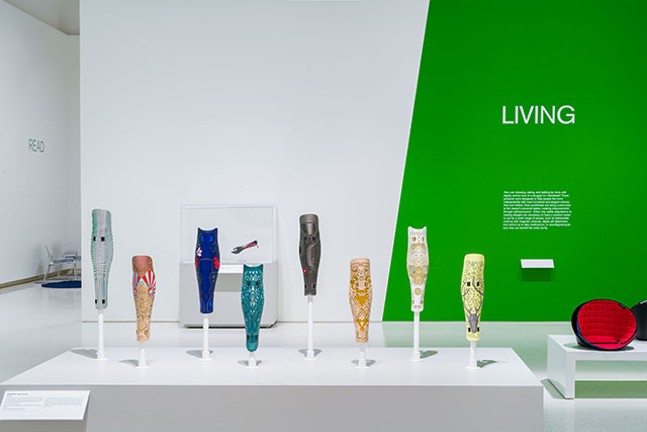It’s important to remember, when talking about disability, that the term is much broader than we normally think. It's such a broad umbrella that encompasses things you can be born with, like autism or blindness, but also a broken leg or Alzheimer’s. In 2016, the Centers for Disease Control and Prevention reported that one in five Americans lives with a disability. Technology designed for people with disabilities, therefore, is not a niche field, but one that can and will benefit everybody.
Access+Ability, on display at the Carnegie Museum of Art (CMOA) until Sept. 8, features a collection of functionally and aesthetically innovative tools that reshape how people with disabilities can navigate the world.
The exhibit highlights more than 70 products — both those currently in use and those in development — designed to assist those with physical, cognitive, and sensory disabilities in everything from showering, to telling time, to playing games. The exhibit originated at the Cooper Hewitt Smithsonian Design Museum in New York.
“Many of the products in Access+Ability exemplify the best of contemporary design. That is, they are aesthetically and materially suited to their purpose, attractive to their users, and fulfill real human needs,” says curator Rachel Delphia.

Access+Ability is a tactile exhibit, with many of the pieces on display available for visitors to touch or use. You can touch the silicone handle on a series of canes by the Michael Graves Design Group, designed not to slip when propped up against a wall. There is a sample of a magnetic shirt to open and close, designed by MagnaReady, to make it easier for those with limited dexterity to get dressed. The “Joy For All Companion Pet,” a robotic puppy designed by Ageless Innovation as a companion for those with dementia, patiently waits for visitors to pet it so it can bark and wag its tale.
Other pieces, while not available to touch, feature a video demonstrating their use in the real world, like blind runner using GPS wristband “Wayband,” designed by WearWorks, to provide directions via vibrations, helping him run the New York Marathon. Another wristband, the “Emma Watch,” helps stabilize hand tremors to make writing clearer. Every video shows all the ways the product is successful and the joy of the person using it, but it would’ve been interesting to also show ways in which a certain product doesn’t always work for everybody with the same disability.
Any visitor to the exhibit can learn about what technology is useful for different disabilities, and what strides have been made. Delphia also says the exhibit has made CMOA reflect on ways to be more inclusive and accessible for all visitors. “The products themselves and the entire context of the show have opened our minds even more than we anticipated,” says Delphia. “The challenge is prioritizing ways to make the greatest impact.” Delphia notes that the exhibit itself features Braille labels for all of the pieces, as well as frequent hand sanitizer stations so everyone can feel comfortable touching the pieces. CMOA will also offer accessible programming in conjunction with the exhibit, like tours with American Sign Language, tours with visual descriptions, and more.
Part of normalizing disability is not only creating products that expand what people can do, but also broadening how people perceive these accessories. Something like a hearing aid, for example, typically only comes in beige or silver colors to blend in. But there’s no reason it can’t be as aesthetically vibrant as any other accessory. Elana Langer’s “Earring Aid” features a typical hearing aid bejeweled with Swarovski crystals, making it more of a fashion statement. Similarly, the prosthetic leg covers by ALLELES Design Studio feature intricately carved designs on a piece meant to cover typically plain prosthetic legs. A prosthetic arm accessory, the “Ivania 2.0,” is a saucier iteration — a prosthetic arm that looks like a red and black corset, perfect for “holding a wineglass at dinner,” as it’s described.
Access+Ability thoughtfully showcases how, even though we live in a world that was not built to be accessible to those with disabilities, there are constant innovations, changes, and progress made. There are things possible now that were not so 10 years ago, and if the products in the exhibit are any proof, the same will be true 10 years in the future.


